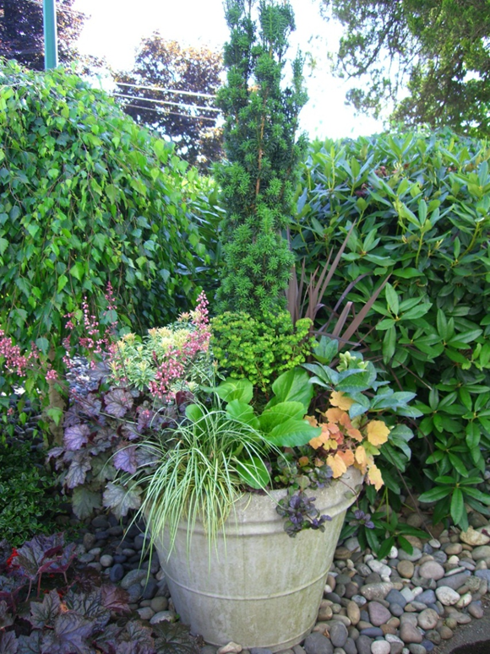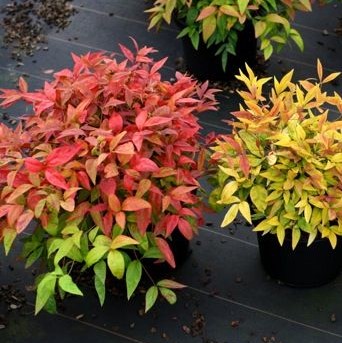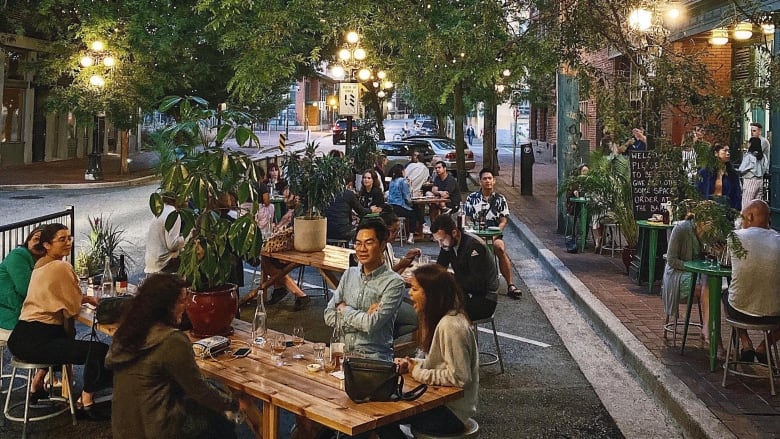Winter planting displays are great for businesses in Metro Vancouver, helping to improve their customers’ experience and satisfaction, ideally along with their overall bottom line.
With BC’s ideal growing climate, this is a great time of year to freshen up the colour and appeal of your establishment’s exterior plant material displays. Making your entrance stand out (in a good way) doesn’t work well when your flowers wither and your shrubs lose their leaves.
Thankfully, many beautiful winter plants exist that can bring colour and life back into the bleak, grey atmosphere of Vancouver’s colder season. Unlike most plants, they actually thrive in this type of weather!
The dark, the grey, and the wet can certainly be a drag… but also an opportunity for savvy restaurants to stand out with strategic plant displays that attract a TONE of attention!
Within this guide, we’ll cover our 10 favorite winter plants to use in a potted display and we’ll break down the components involved in creating visually appealing displays so that your business is fully prepared to stand out this winter!
What are 10 of the best plants for winter displays?
1. Red Osier Dogwood
Cornus sericea, Deciduous shrub

Dogwood is a great addition of bright red to a display. It provides necessary height and can be used as the centerpiece when mixed with other smaller plant material. It matches the red theme of the holidays and is super easy to plant and maintain.
2. Lenten Rose
Helleborus orientalis, Perennial

This plant actually blooms in late winter making it quite unique! It comes in a variety of colours and is a very popular choice for winter displays given its special bloom cycle!
3. Pansies
Viola tricolor var. hortensis, Annual flower

Pansies are great to use in the winter since they are hardy and able to survive in colder conditions. They come in many colours and varieties so you can really customize a display with them. While frost does tend to cause wilting, they bloom again in early February and can stay flowered into December with the right conditions.
4. Primrose
Primula vulgaris, Annual flower

Primrose like the pansy comes in many colours. It’s also useful for designing custom displays with colour. They can withstand the winter cold without their flowers wilting. They are also used to replace pansies in displays by late winter.
5. Taxus Yew
Taxus baccata, Evergreen shrub

Taxus is an evergreen shrub. It is commonly used for hedges. However, it‘s also an excellent centerpiece and focal point for a display. Bringing in the height aspect, it can be matched with smaller plants to create a beautiful display. You need to use a young plant because they can grow quite large over time.
6. Nandina
Nandina domestica, Evergreen shrub
While the leaves remain green for most of the year, nandina’s leaves do change in the winter to beautiful bright shades of red and yellow. It is an excellent choice for use as a filler plant surrounding whatever is used as the centrepiece feature.
7. American Wintergreen
Gaultheria procumbens, Evergreen shrub

American wintergreen is another example of a filler plant that can make a display pop with bright red berries. This is quite popular in the winter due to its holiday vibes, but it is also just a reliable plant to choose for a winter display.
8. Coral bells
Heuchera americana, Perennial

Coral bells can be found in a variety of different deep colours such as purple, red, and even lime green. It has nice wide leaves which tend to contrast the needle shrubs.
9. Conifers
Pinophyta, Evergreen shrub

Conifers are evergreen shrubs that have cones for seeds. Using a very young conifer tree can give the aesthetic of a mini-Christmas tree. Like the Taxus Yew, it can serve as the centre piece and height of a display.
10. Sweet Flag
Acorus gramineus ‘Ogon’, Herbaceous perennial

This grass adds year-round texture and colour, with bright yellow/green foliage that can act as an excellent ground cover. They also perform well in boggy, wet soils, making them ideal for wetter conditions.
How do the different components of a plant display work?
The components of a plant display can be broken down into three main sections: Thriller, filler, and spiller. By combining all these components, you will have a beautiful winter entrance or patio display that will attract the eyes of many to your door.

Thriller
You should always start with the “thriller” of a display. As the name suggests, this is the biggest, most bold element within your display. Its purpose is to make a statement that grabs the attention of your desired audience.
You want the thriller to have height and to stand up taller or wider than the other elements. The shapes you choose should be strong and pronounced.
Filler
This component includes all the foliage and flowering plants surrounding the thriller. Again, the name says it all.
Fillers are used to fill in empty space left within the pot. You should use these plants to compliment the larger focal point while occupying the leftover empty space.
It’s very important not to overwhelm the thriller while still disguising its base with mounding, billowy shapes. Fillers are usually made up of a variety of different shrubs and flowers becoming crucial for executing an effective design.
Spiller
Finally, the spiller trails out of the container and brings the entire display together. It is the skirt surrounding the other elements both softening the edges of the container and anchoring the display pot to the ground.
Spiller usually serves as a great counterbalance to the thriller which stands tall above the other plants. Adding colour and texture below the pot rim will establish a more balanced display.
Now that you know the three components, go back and see if you can organize our plant list into the categories!
How should you create a winter plant display?
The three main factors to keep in mind while designing a high-quality display are colour, placement, and texture.
Colour
In terms of design, colour is one of the most important parts of a display. Imagine this scene, a possible customer is walking down the street, its raining, the buildings are grey, the road is a darker shade of grey… The LAST thing you want is to blend into this dreary scene. That’s where colour shines most, especially if it is coming from live plants contrasting their expectations of a dead winter!
Colour also affects our emotions which can then lead to a change in behaviour. We tend to use three forms of colour design, which you can implement into your own displays depending on your restaurant’s branding and theme.
Complimentary
As you may already know, complimentary colours are, well, complimentary! Opposite to each other on the colour wheel, matching your display based on this colour design is a safe bet to use.


Analogue
Analogue utilizes three adjacent colours upon the wheel to create a unified end look. Usually, it involves a dominant primary or secondary colour and then two supporting tertiary colours. Often analogue designs will also include an accent colour for more of a pop.


Monochromatic
Monochromatic colour schemes are different from the other two because they involve one base colour extended through different tones and tints. Tint comes from adding white while tones are the opposite adding dark colours, grey and black.


Placement
The placement of your plant material within a planter depends a lot on the viewpoint of the display from an entrance or patio. If the planter sits against a wall or barrier, thrillers should be placed at the back and filler/spiller in front to fill the leftover space.
If your entrance displays are further out on the street, the thrillers should be placed in the middle of the planter with filler/spiller surrounding it from all sides.

Example of open centered display

Example of wall backed display
Texture
Finally, using different species of plants is important because of the texture it adds to a display. Different shapes and sizes of leaves, flowers, and shrubs provides depth to the display that would otherwise appear flat when walking by.

Why winter plant displays are worth the effort for restaurants?
Flexibility
Once you implement a plant display around your entrance or patio, every new season you’ll likely have a year-round thriller plant surrounded by fillers nearing the end of their bloom cycle. The good news is that it‘s very easy to quickly replace filler and spiller plant material with fresh and trending new plants.
Just like having seasonal products to keep things fresh for your customers, and to meet upcoming trends, a seasonal plant display will certainly become a feature loved by many!
Biophilic design is trending, urban forests are popping up more and more, and the flexibility of a plant display allows you to hop onto these trends quickly with little cost.

Focus
Potted plant containers create interest and draw our attention. And when grouped in strategic places, they break the monotony of a street to establish an ambient scene.
When matched with the theme of your business, plant displays can improve branding and act as a straightforward focal point in which to attract focus for displaying signage, the front doors, or patio entrance.
Speaking about winter in specific, these advantages are all amplified with use of the colourful winter plants we listed above!
Ambience
Finally, plant displays simply set the stage for outdoor and indoor spaces alike. To create a more formal display align your containers and use traditonal pruning techniques. In contrast, less contained and polished looking displays exemplify a natural, and rustic vibe.
Without any words, you can communicate a clear message to your customers. A message that is only amplified by the grey tones of winter.
Plant Display Maintenance and Our Expert Team
Winter plant entrance and patio displays can give a nice visual advantage in attracting customers. However, plants are living things and therefore require some upkeep.
This upkeep changes depending on the season. The components involved are watering, fertilization, pruning, and location. Certain plants are easier than others to maintain, but when it’s all said and done the cost of time seems quite acceptable given the value they add.
If you are interested in learning more about the different sizes, planter types, materials, and acquiring custom designs for your own business, feel free to reach out to our expert team! We’ve been doing displays for over 40 years, and we would be more than happy to give you a free consultation.




Comments are closed here.